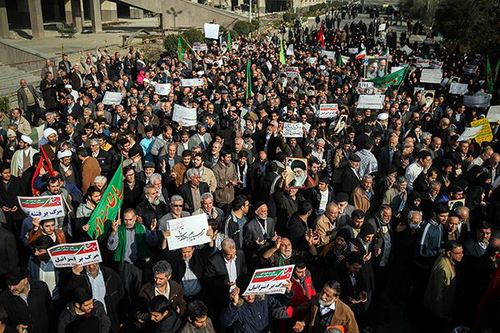Lessons learned as the Iran protests come to an end
- By Sabena Siddiqui
 0 Comment(s)
0 Comment(s) Print
Print E-mail China.org.cn, January 11, 2018
E-mail China.org.cn, January 11, 2018

Protests in Iran [Photo/rmzxb.com.cn]
At the cusp of 2018, Iran dominated front-page news as protests broke out in Mashhad and spread to more cities. Though protests never reached the scale of those during the 2009 elections, small demonstrations grew into rallies as events rolled out, eliciting global concern. Now that the situation has abated, it is important to understand how it started, and surprisingly, the furore, according to Professor Hussein Banai of Indiana University, arose out of a flimsy basis. "It started over a protest over the price of eggs, believe it or not," he said.
With prices of basic food items on the rise by roughly 40 percent since the year 2016, things took a turn for the worse as bird flu broke out. The epidemic resulted in an acute shortage of 17 million poultry, which in turn caused egg prices to spike by 50 or even 100 percent, leading to discontent that later devolved into widespread protests. Initially the working-class base objected to the food inflation, then the protests spread from the rural areas towards Tehran. This was counter to the 2009 protests, which spread from urban areas towards the villages and small towns. Having a multiparty election system, Iran has fortunately proved more resilient to street demonstrations than most countries in the Middle East.
As the story developed, the United States and other countries began to consider helping the people of Iran; the world suddenly sat at attention and the debate started over what was happening in Iran. Even so, no "actionable information" could be found by the White House, so imposing sanctions was ruled out. Outside interference would have been inadvisable, as such crises remain an internal matter and Iran was rightfully left to manage its domestic issues autonomously. With tremendous foresight, the Iranian government adopted a mild approach and President Hassan Rouhani observed that a "space for criticism" must be provided, but violence was deemed unacceptable. This display of political maturity proved effective, and the protests that heralded in the New Year have now died down.
Iran's elite armed forces, the Revolutionary Guard, did not have to use force, though it has more than capacity to quell a rebellion. Having controlled the situation, the head of the Iranian Revolutionary Guards, Major General Mohammad Ali Jafari announced, "Today, we can say that this is the end of the 96 sedition," – it is the year 1396, according to the Persian calendar. He further said that "security preparedness and people's vigilance" had led to the defeat of "enemies" and only a "limited" intervention was needed in three provinces.
Commenting on the Iranian Revolutionary Guard, Suzanne Maloney from the Brookings Institution's Center for Middle East Policy said, "This is a very effective and savvy security service; they will seek to deescalate, using violence [if] necessary, but not in a way that's likely to provoke further outcry." She went on to conclude, "This is a set of circumstances that very few outside analysts anticipated, and that Iranians themselves did not appear to be prepared for. It is impossible to predict exactly where it ends."
Consequently, underlying issues must be addressed; as a younger population requiring more employment drives social change, the long-term economic outlook will have to improve. Building frustrations over rising costs reflect a demand for higher living standards. Notably, however, the protests kept to a much smaller scale than those held in 2009. According to research on non-violent revolutions by Erica Chenoweth from the University of Denver, falling governments usually face demonstrations where 3.5 percent of the population are involved in sustained nonviolent activity. For Iran, that would mean nearly 3 million people on the streets from its population of 80 million, and so these much smaller protests can be thought a mere flash in the pan.
According to Tehran-based political analyst Mojtaba Mousavi's assessment, most Iranians do not support violence no matter what issues they have with their government. He explains, "There are certainly Iranians who aren't happy with certain policies, frustrated people who would like to protest against their economic situation, but history shows none of these people support violence and subversion."
Negating all the undue exaggeration, there was never any existential threat to Iran – the protests never qualified as a "revolution," the government kept its cool and convinced the crowds to disperse. Having said that, proactive steps will have to be taken by the Iranian government to prevent any resurgence and sudden escalation in the future.
Sabena Siddiqui (Twitter: @sabena_siddiqi) is a foreign affairs journalist and lawyer based in Pakistan.
Opinion articles reflect the views of their authors, not necessarily those of China.org.cn.






Go to Forum >>0 Comment(s)